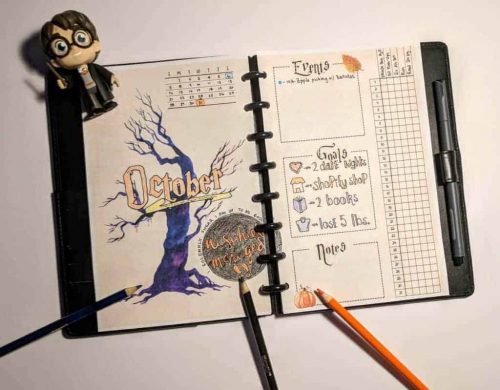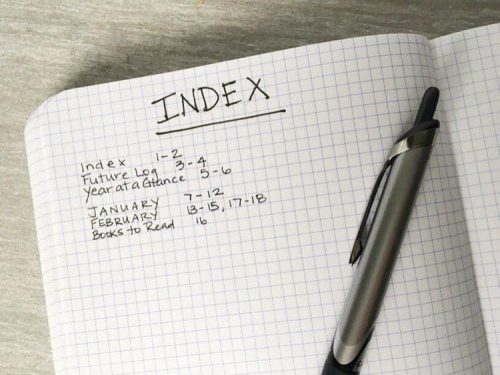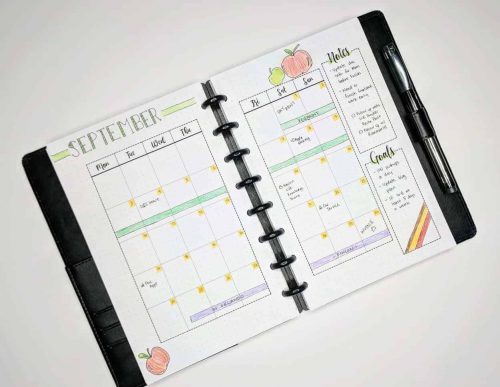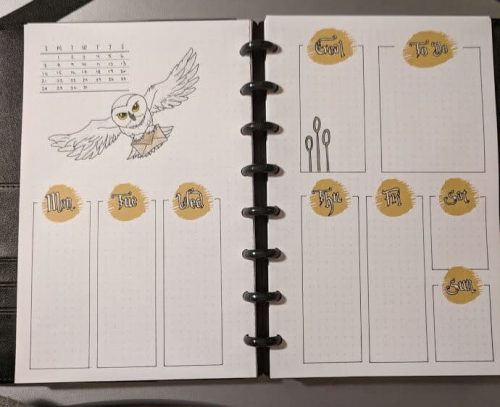As a type A perfectionist, I spent months drooling over incredible bullet journal layouts on Instagram before I finally gave it a try. I was so nervous about screwing up a page I just couldn’t get started. I loved the idea of finally having a planner and journal customized for me, but I didn’t know how to bullet journal. And I knew that I didn’t have the right-brain skills (or insane amount of time) to make every page look like a work of art.
Finally, I found a system that worked for me. It isn’t scary. It doesn’t take tons of time. And you don’t have to worry about lettering, watercolors, and Washi tape if you don’t want to.
Here’s what you need to know.
What Is A Bullet Journal?
Here’s something that might surprise you. Bullet journaling, in its intended form, had nothing to do with beautiful artwork and creative expression. Instead, it had everything to do with mindfulness and helping people quickly and clearly keep track of the things that were most important to them.
Bullet Journaling, or BuJo for short, was created by Ryder Carrol, a digital product designer. It was a system of organizing long paragraphs of notes and multiple journals into a series of bullets. These different bullets denoted tasks, notes, events, and more.

By organizing things into bullets, it is easy to get a bird’s eye view of your life and to-do list. And by making it fast to jot down notes, the theory was you were more likely to do it consistently.
But, wait a moment, have you ever seen a picture of a bullet journal layout that was just bullets? Probably not. For one, it would make a terrible Instagram picture.

More importantly, the system has grown.
Bullet journaling today is a way to organize your life and goals in a way that works best for you.
You can use bullets, draw, color, paint, or change layouts each week or month based on your needs. No longer are you trapped by a journal designed for someone else with a life that isn’t yours. You can create pages that track no spend challenges, mood, weight loss, debt repayment, or any other goals.
A bullet journal is a journal. And a planner. And a goal tracker. And whatever else you need it to be.
Why You Can't Replace A Bullet Journal With Your Phone
My entire life is online. My business, my friends who now live scattered far around the world, pictures of the boys uploaded to the cloud, meditation. But while I love my phone and the internet for oh so many things, it has never fit the bill for journaling. And trust me, I tried.
Habit tracker apps, daily journal apps, Google calendar reminders, Evernote, OneNote. You name it, I’ve probably tried it.
Sure, Asana rocks my world for organizing my business. But when it came to setting goals, learning to journal nightly to reduce stress, and staying on track with my family to-do list, paper beats any app every time.
And it turns out, studies show this is pretty standard.
Writing stimulates the reticular activating system (RAS) in our brain. This fancy part of our brain acts as a filter for everything that giant, complicated organ has to process. So, by writing instead of typing and waking the RAS up, we signal to our brains that that information is more important.
In short, our brain allows us to remember things, get clear on our thoughts, and reach our goals more easily if we write with pen and paper.
(Full disclosure: I’m not a neuroscientist, I just read some stuff.)

So, if pen and paper is the way to go, couldn’t you just grab any old journal? Maybe. But any old journal is going to try to put you in a box. And you, my friend, are not cookie cutter.
A bullet journal lets you organize things your way. Sketch if it helps you think. Add gratitude boxes to your weekly planner. Put your habits front and center or make your journal the star. Whatever you need to reach your goals, you can do it with a bullet journal.
But Don't You Have To Be Artistic?
Oh goodness, no.
Remember how this guide was for perfectionists? I’m a right-brain, number-crunching girl. You could maybe call me creative. But artistic? Not a chance.
Don’t let Instagram images and people doing full-scale art in their bullet journals scare you off. Remember, bullets. This whole thing was meant to be a list of bullets. You CAN make it more creative than that, but you definitely don’t have too.
And in fact, that is what this whole post is about. How to make your bullet journal pretty and fun to work with even when you (a) aren’t super artistic, (b) are a busy parent who can barely find time to shower, or (c) really would just rather someone handed you something that fun but already more structured for you.
You ready? Let’s get started.
What Do You Need To Bullet Journal?
For classic bullet journaling? Not much.
All you really need is a journal – blank, grid, dot grid, or lined – and a favorite pen. You can, however, get a little more fancy as time goes on. And some journals work better than others. (No one wants their ink seeping through cheap paper – ick!)
But for type A, perfectionist, busy parent journaling there are a few tools that make the process a million times easier. So, here are a few of my favorite products for each method.
The Perfectionist Bullet Journal Method
The perfectionist bullet journal method is when you recognize and accept one simple thing.
There isn’t time in your busy life to make every page perfect. But you’re still going to want it to look good.
So, you need a way to not be afraid of screwing up. Of not panicking that pages will be in the wrong order or that you’ll decide you want to start tracking an important habit halfway through the year with no way to house it right up front where you want it. A way to add a weekly layout when you don’t have the time to sit down with a ruler to measure it out.
The saving grace to give you that peace of mind is a discbound notebook.

Why do I love discbound notebooks and recommend them to all my Type A friends? Let me list the reasons…
- You can swap out the pages quickly and easily. No worrying about having the perfect order!
- The notebook always lays flat for easy writing. And if you want to avoid having your hand on the rings for left-hand pages, you can pop it out of the notebook then just put it back in when finished.
- You can print base templates you use over and over (like weeklies), without having to spend time sketching them out each week.
- You can always have a scratch page in front for quick notes to add to your main pages when you have time, that can just be thrown out.
Discbound notebooks are cheap and come in many options. I like the TUL Custom Notetaking system in the Junior size, as the pages are exactly half a standard sheet of letter paper which makes it simple to print and add pages. It is also a similar size to a classic bullet journal.
To add pages, you’ll need a special discbound hole punch. Most discbound notebooks have the same hole punch structure (TUL, Levenger, Martha Stewart, Arc, etc.) but note that the Happy Planners does not use the same system. If you choose a Happy Planner, you’ll need to get their punch. Which is usually more expensive than other options, unless you can snag a good JoAnn’s or Michael’s coupon!
I really like the TUL hole punch which punches easily through heavyweight paper – I typically use heavyweight to avoid ink bleed – and can punch sheets to fit my junior size TUL or my full-size Levenger notebook.
The Best Classic Bullet Journal Tools
What classifies a good classic bullet journal? Any notebook that holds up well over time (you’ll probably keep the same journal for about a year) and has high-quality paper so ink doesn’t run through the pages.
Most people prefer dot grid paper, so you have a little guidance to keep lines straight and everything evenly spaced, without being boxed in by solid lines. But choose what works well for you.
These are the three most popular notebooks for bullet journaling.
Moleskin Classic Notebook, Dotted – quality notebook that lies flat, but thin paper
LEUCHTTURM1917 Official Bullet Journal – has built in index, key, and future log for journaling
Rhodia Black Webnotebook, Dot Grid – very high quality paper, pens rarely bleed through
My Favorite Pens, Pencils & More
The tools people use to bullet journal are where things really get creative. Some stick to the original method of ultimate simplicity and just use a ballpoint pen or whatever is lying nearby. Many use fine-tip marker pens for a cleaner, crisper look. Then there are those adding colored pencils, Washi tape, watercolor, pastels, and so much more.
While what you ultimately use will really depend on how in-depth you get with your bujo (and how much you use it as a creative outlet), I wanted to include some great tools here. These are the things that live in my pencil case when I travel and otherwise sit on my desk everyday.
Sharpie Fine Line Pen – I use these for all my notetaking and sketching. They don’t bleed and are easy to find.
Taotree Fine Line Drawing Pens – I really love that these pens don’t bleed and write crisply. Plus, they’re cheap!
Magic Rub Eraser – Remember that perfectionist thing? Well, I like to outline in pencil first and this eraser leaves no trace.
Prismacolor Premier Colored Pencils – A little pricey but excellent quality. Good for simple coloring or more detailed blending.
Helix 6-inch Ruler – No one likes squiggly lines that are supposed to be straigh!
Decorative Washi Tape – Cute, quality masking tape to add quick decorations to your pages, add in inserts, or create tabs.
When adding new bullet journal tools, remember to start small. You don’t need anything besides a notebook to get started, and surrounding yourself with too many tools early on might make it less fun (and more overwhelming). Use the Crayola colored pencils you have around the house and have fun with it!
Basic Bullet Journal Layouts
To keep from pulling your hair out with your bullet journal, there are a few key types of pages and layouts you want to include. These will help you keep things organized, especially at times when you are making quick notes or have to log something for the future.
I’ve broken down each component below, along with an example. Remember my note above about tools – you’re going to start small. You don’t need all these things the first day and just starting with two to three pages at once is plenty.
Bullet Journal Key
Because a bullet journal is meant to be a list of bullets a short key will help you create a system to log the different aspects of your life. This can include to-do list items, events, notes, memories, and more.
The most useful aspect of a bullet journal key can be creating a system for tracking progress on your task list. Is something in progress? Complete? No longer relevant? Have a quick, simple way to log it.
Keep this page towards the front of your journal when you start, so you get in the habit of sticking to the system. Over time, it will become second nature. Like riding a bike or checking Facebook.

Index
Admittedly, this is somewhat less important in a discbound bullet journal. It requires numbering pages which I don’t do because I often shift the order of pages to keep things I reference regularly towards the front. But, in the absence of an index, I do make Washi tape tabs and have a ruler bookmark that clips into the rings to mark where my current weekly page is.
But, if you plan to use a standard bullet journal, this is crucial. It might seem really silly when you’re new. Like, will you ever really reach a point where you can’t just quickly flip through all your pages to find something you’re looking for?
Yes. Yes, you will.
When you want to look up something from April. Or you add some vacation memories pages in the middle of your journal that you want to re-read. You’ll quickly realize that flipping through every single page is precious time you just don’t have.
An index is your table of contents. As you move through your journal, number each page so you can record where things are in the index. That way, when you need something, you can find it efficiently.

Index from The Lazy Genius since I don't have an index 🙂
Future Log
A future log is a place where you can record things you’re planning for, well in advance. Events or reminders that you’ll want to add to your monthly planner, once it’s set up.
In a standard planner, all the months and weeks are there, ready to use, the moment you buy your planner for the year. But in a bullet journal, things are a little different. You are adding monthly and weekly layouts as you go.
As such, when you find out about an event you’re going to have to attend in November, but it is only June, you probably won’t have a place to log it yet. Unless you have a future log.
A future log is also an excellent place to see your major events for a year or long time period all in one place. It is super helpful for taking a step back and evaluating travel plans or holidays.

Monthly Organizer
This is pretty straightforward. It’s your spread to plan your month, possibly track any goals for the month, and make notes. Very similar to a standard planner.
Often, these spreads don’t have room for a ton of information. Instead, they have a fun design to act as a cover for the month and record important dates or tasks.

Weekly Organizer
Wait, wait, can you guess what this is? It’s a organizer for your week. Usually following the monthly layout. Bet you didn’t see that coming.
While this can look like a standard planner for some people, often it works as more of a journal for others. My weekly organizer has a to-do list and a space for events. But in the daily boxes I actually journal before bed to reduce stress.
In my opinion, the weekly organizer is when the ring planner method of bullet journaling comes in most useful. Measuring out the boxes for your log every week can create a barrier to sticking to bullet journaling. You just want to plan your week. not spend 20 minutes drawing the system first.
Luckily, with a ring planner, you can find a design you love and print of more pages as you need them.

You might have noticed I like Harry Potter...
Goal & Challenge Trackers
This is where bullet journaling gets fun. The act of physically writing down your goals, then checking in daily on your progress, is the secret sauce to making long-term change. You mentally revist what you want regularly, so it becomes a focus. And the visual representation of how you are doing is powerful.
These spreads can track weight loss, water intake, important habits, mood, sleep, or anything that matters to you.
I have a monthly spread to track my mood. I have a weight loss page and one for my annual goal to read 30 new books. Then, I have a monthly habit tracker to encourage me to walk, drink water, read, and stay on top of other habits.
People who write down their goals are more than twice as likely to achieve them. If you have major goals, starting to track them, especially in a visually appealing way, will help you make progress.

Collections
Collections organize any information you want to keep track of. They can include pages for internet passwords (if you don’t have an emergency binder), birthdays, books you want to read, movies you want to watch, or your bucket list.

How To Start A Bullet Journal
Alright, you know everything you need to know about bullet journaling to get started. So, what do you tackle first?
A lot of “how to bullet journal” guides will tell you to design your key, make an index, and create a future log. But I say screw that.
Before writing a word in your first bullet journal, consider WHY you want to do this. Are you looking for a versatile planner? Do you have huge goals you want to reach? Or do you just love adult coloring books and want a reason to be a little artistic while keeping your life organized?
Your reason will dictate where you start. My first bullet journal pages were goal trackers. I love setting goals but sometimes have trouble staying on track. And when I was working in finance, I needed a creative outlet. So I created fun goal setting sheets to help me tackle both things.
Then, I added a monthly layout with room for a happiness box each day, where I would write one great thing from the day before bed. Finally, I started to add weekly planners and collections. I created a separate binder for the blog and my business goals. I started small, and let things snowball.
In short, here’s my pro-tip advice.
Start by making the layout that has you most excited about bullet journaling.
Once you have a fun layout that keeps you coming back every day, add other pages and layouts as need be. The discbound system will allow you to grow at your own pace without feeling locked into the page order of a traditional journal.
We perfectionists often want everything to be 100% perfect right out of the gate. But any time you are developing a new skill, you need to give yourself time to adjust and develop. Starting small gives you the ability to perfect just one thing, before moving on.
Make It Easy
When you’re getting started with your first bullet journal, or making another attempt to make it a habit, keep things as simple as possible.
If you choose not to use a discbound journal, try starting with a good journal with fewer pages. This way, you won’t be stressed about working out the kinks on your early pages and muddling a whole (expensive) journal.
No matter the system you use, find printable layouts that fit your needs. Or choose very simple layouts that are fast to copy out. A common sticking point is needing a new weekly or monthly page and not having the time to draw a new one, or worrying that you can’t make it as beautiful as the last one, so forgetting the journal altogether.
Removing barriers is important in the first weeks and months when you are building the habit. I, for one, avoid hard things. Which might be why the “run” column in my habit tracker looks so blank…
Don't Get Planner Envy - Do YOU!
In the age of social media, it is easy to feel envious of talented people who seem to have hundreds of hours on their hands. And that is never more true than when looking at #bulletjournal and #bujo on Instagram. Those people are incredible. Certainly, they are a great place for ideas. But don’t get caught up in comparisons.
Make your bullet journal what you need to reach your goals and stay on top of things. Don’t create layouts you’ll never use just because it looks cute or you think you’re supposed to.
The beauty of bullet journaling is that it’s unique. You do YOU! Have fun with it, my friend. I’m sure I’ll be drooling over your Instagram layouts in no time!
Be sure to comment below or DM me on Instagram with your first bullet journal pages!













